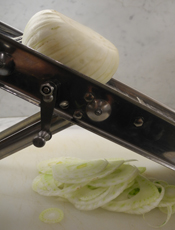Fennel 101
Sources include: On Food and Cooking by Harold McGee and Field Guide to Produce by Aliza Green.
Fennel, also sometimes called finocchio or florence fennel, is the plant that produces fennel seeds -- which may be more familiar to home cooks than the fennel plant itself. Fennel are white and green bulbous plants that in their whole, raw state look a bit like a vegetable version of Sideshow Bob with its rounded shape and topping of lacy green fonds.
Fennel is a year-round vegetable that like an onion has a bulbous shape and layers -- but its flavor is nothing at all onion-like. Instead its taste is fresh, ever so slightly sweet, subtly anise when eaten raw, and more distinctively so when cooked. When raw, its texture is crispy and wet like an apple; when cooked its texture softens.
High in fiber and low in calories (1 cup raw = 27 calories), fennel contains lots of vitamin C and also counts iron, calcium, folate, potassium, and riboflavin among its nutrients.
How To Buy and Store Fennel
- Look for fennel bulbs that are white with an ever so slightly green tint, with few brown spots and no splits in its outer surface. The bulbs should be topped with a few stems plus feathery fonds, and feel firm and solid in your hand. Avoid any that seem shriveled or soft.
- Once home, leave your fennel in the plastic bag you bought it in at the market and store it refrigerated for up to 5 days.
Preparing Fennel
- The entire fennel bulb is edible. The lacy fonds on top are tasteless but can be a nice garnish so save a few when trimming the fennel.
- The first step in prepping fennel is to cut off its top, removing the tower-like stems and stems of fonds. Cut off any dark spots and if the bulb's outer layer seems thick, cut this off. Also cut a thick slice off the bottom so to remove any dirt or dark spots.
- Fennel has a thick and somewhat coarse texture and especially if you're going to use it raw, how you trim and cut it makes a difference in its eating. Two of the best ways to serve raw fennel are either in very thin slices, cut with a mandolin or ceramic slicer, or else cut into small pieces that will be easier to chew.
Cooking With Fennel
- Raw fennel is an excellent addition to salads and slaws, adding it either in thin slices or in small chunks. When sliced thin, it also makes an excellent topping for sandwiches in place of the usual lettuce leaves. One of my favorite ways to serve fennel is in a simple salad in which thin fennel slices are tossed with a red wine vinaigrette and bits of pickled jalapenos -- its fresh but piquant flavor is a great match with fish or roast pork. See our recipe.
- When cooked, fennel can be the centerpiece in a gratin, added to soups and also tomato sauces. We found a very appealing and simple recipe by Martha Stewart for baking fennel wedges with grated Parmesan cheese. See the link below.
- Fennel seeds are often toasted and either used whole or ground into a powder to flavor Italian sausages and Indian spice mixes.
- Fennel is also a main ingredient in a classic Sicilian pasta dish that combines spaghetti or bucatini with sliced fennel, sardines, and sweet currants, and garnished with some of the lacy fennel fonds. The combination of sweet currants, salty sardines, and the anise fennel is irresistible, something you could imagine Prince Fabrizio in Lampedusa's The Leopard having for dinner every Friday night.

